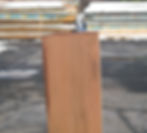Redwood
Description
Redwood (Sequoia) is an American wood, obtained from some of the world’s tallest trees, many reaching over 270 feet in height and with trunk diameter's of up to 10 feet, but found only in the coastal regions of Northern California. The Redwood trees of California have been harvested since the time of the first Spanish settlers over 400 years ago. It is a highly prized lumber product renowned for several unique qualities not found in other woods--even woods treated with chemicals. Redwood performance characteristics include resistance to decay, insects, shrinking, warping and checking in addition to durability. This means redwood projects age beautifully. Decks, fences and shelters made with redwood simply look better ten, fifteen and twenty years after construction. No other softwood has the rich beauty or the long-lasting performance of redwood heartwood.






Common Uses
-
Veneer, construction lumber, beams, posts, decking, exterior furniture, and trim. Burls and other forms of figured Redwood are also used in turning, musical instruments, and other small specialty items.
Technical Specifications
-
Common Name(s): Redwood, Sequoia, Coast Redwood, California Redwood, Vavona (burl)
-
Scientific Name: Sequoia sempervirens
-
Distribution: Coastal northwestern United States (from southwestern Oregon to central California)
-
Tree Size: 200-300 ft (60-90 m) tall, 6-12 ft (1.8-3.7 m) trunk diameter
-
Average Dried Weight: 26 lbs/ft3 (415 kg/m3)
-
Specific Gravity (Basic, 12% MC): .36, .42
-
Janka Hardness: 450 lbf (2,000 N)
-
Modulus of Rupture: 8,950 lbf/in2 (61.7 MPa)
-
Elastic Modulus: 1,220,000 lbf/in2 (8.41 GPa)
-
Crushing Strength: 5,690 lbf/in2 (39.2 MPa)
-
Shrinkage: Radial: 2.4%, Tangential: 4.7%, Volumetric: 6.9%, T/R Ratio: 2.0
*Source: The Wood Database; https://www.wood-database.com/
